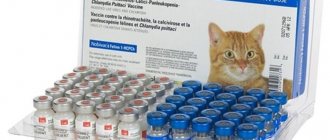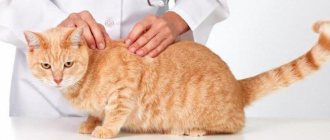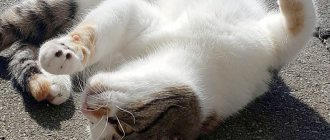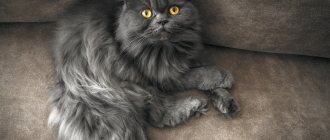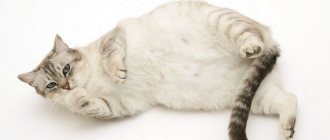When caring for pets, especially during the molting period, purified sulfur is included as a dietary supplement in the diet for cats. It participates not only in metabolic processes, but also in the construction of cellular structures of the cat’s body. This element contributes to the production of energy, the production of chemical compounds of collagen and keratin, the preservation of genetic information, and the normalization of tissue respiration.
The health of an animal depends not only on proper nutrition, but also on care. It is important to carefully monitor the cleanliness of the animal, especially the cat’s ears. If your cat's ear is leaking, it is necessary to clean it on time.
Number of allocations
Some cat breeds have large ears, for example, Maine Coon, Abyssinian, Oriental, Somali. The ears of these breeds collect more dust and dirt, which settles on the inner surface of the ear, which stimulates additional wax production to protect the inner ear from infections. However, some types of cats have dirty ears all the time because they produce more wax than other breeds. We are talking, for example, about the sphinxes. Hairless cats do not have ear hairs that could prevent dust, dirt and infections from entering the ear. These cats can have their ears cleaned more often than others. Some owners do this every day. However, in fact, cleaning the ears of a Sphynx cat is really necessary only before the exhibition, and on weekdays the question of how often to clean the animal’s ears is decided depending on the situation.
Folk remedies
If for some objective reason a visit to the doctor is temporarily impossible, then traditional medicine comes to the rescue. Herbs and lotions are unlikely to be able to completely cure otodectosis, but they may well be able to alleviate the animal’s suffering until the time of visiting the veterinary clinic.
- Green tea based drops. A tablespoon of dry leaves is poured into a glass of water and left for 5-10 minutes. After cooling to a warm state, the solution is taken into a pipette and a few drops are instilled into each ear.
- Garlic has powerful antiseptic properties. In the case of ear mites, it is infused in oil for 24 hours, and then the resulting solution is instilled into the ears once a day. Olive, flaxseed, sunflower, almond and other oils are used as the basis for the tincture.
- Celandine juice is instilled into the ears in the morning and evening, two drops per ear. Freshly picked herbs are ground in a meat grinder and then squeezed in gauze to prevent any remaining leaves or stems from getting into the juice ready for use.
And the last thing you should not forget about is to try to give the cat maximum attention and care in order not only to alleviate its suffering, but also to speed up the recovery process.
Expression of love and affection
There are so-called “pacifying” pheromones. Their number increases after the birth of kittens and begins to decrease after the cat stops feeding the babies.
It is by the presence of such pheromones that zoopsychologists explain the attachment that a person feels for a cat. By thoroughly licking its owner and then rubbing its muzzle against him, the cat removes “foreign” odors and introduces its own. This is what happens when a furry family member wants to mark their human.
Indications for cats
Experts prescribe the product for scabies, dermatitis, furunculosis and other skin lesions. Food sulfur helps well during spring molting. Cats' fur grows quickly and looks healthy and shiny. It normalizes the substance and processes occurring in the gastrointestinal tract, therefore it is prescribed for ailments of the digestive system. The drug acts as a weak laxative and anthelmintic. Sulfur also has a calming effect and is used for pathologies of the nervous system.
Return to contents
Special cases
Sometimes brown plaque in the ears of a furry pet is not a symptom of otitis media or otodectosis. Particular cases of the appearance of brown matter in a cat’s ears include: plaque in only one ear, a strong nauseating odor from the ears and increased secretion of wax.
Plaque in only one ear
If dark plaque is found in only one ear, and the cat does not refuse food, itching, apathy and redness of the skin, this is simple contamination. The problem can be solved by simply removing the brown deposits using a cotton pad soaked in cleansing lotion. The next day, you need to check for dirt in the ear. If the brown mass reappears, you should contact a specialist.
Pungent, nauseating odor from the ears
Simultaneously with the formation of brown plaque, a sharp unpleasant odor from the ears most often indicates the development of otodectosis or otitis media. In particular cases, a combination of these symptoms is observed with suppuration in the ears, head trauma, neoplasm and food allergies. A veterinarian should be involved in identifying the cause of brown plaque and unpleasant odor.
Diseases accompanied by the appearance of brown plaque in a cat’s ears
The most common diseases accompanied by the appearance of brown plaque in the ears of a pet are otodectosis and otitis media. Both pathologies are deadly, but with timely detection and referral to a specialist, they can be treated quite successfully.
Otodectosis
Otodectosis or ear scabies is a parasitic disease caused by microscopic sarcoptoid mites otodectos cynotis. It is impossible to see the parasite with the naked eye; the arthropod measures 0.2-0.5 mm. Carnivorous arachnids parasitize the external auditory canal, eardrum and auricle, feeding on epidermal scales, blood and lymph. To lay eggs, female mites make multiple punctures in the skin and penetrate into the subcutaneous layers.
Exudative otitis media
Exudative otitis is a pathology of the middle ear, in which effusion (exudative fluid) gradually accumulates in the tympanic cavity. Since the exudate contains proteins, its viscosity increases significantly over time, which leads to hearing loss. The disease often occurs without significant pain, and hearing impairment develops slowly, which prevents the problem from being suspected in a timely manner. Other names for the disease are “gummy ear”, secretory or exudative otitis media.
The continuing interest in this pathology is explained by the variety of clinical manifestations of the disease, the duration of the course, low sensitivity to standard therapy for otitis media, frequent relapses, steadily leading to an obliterating process in the middle ear and, as a consequence, to persistent hearing loss in patients.
Special Moments
An important additive is feed sulfur; the instructions for use contain contraindications and features of administration. Do not forget about hypersensitivity and individual intolerance to the substance, so give a test dose and observe the reaction. In general, no side effects were identified during clinical trials.
Feed sulfur requires careful storage, away from light and drafts. You should not place it next to food or give it to children as games. Since the drug is in powder form, it does not need to be placed in places with high humidity.
The method of using the supplement is simple: depending on the type and weight of the animal, sulfur is added to a regular portion of food. It does not change the taste of the food, so you don’t have to worry about refusing to eat. For preventive purposes, feed sulfur is used during molting periods.
Biological properties
Sometimes owners notice that cats love ear wax and they like the smell of the discharge. The cat eats earwax with pleasure, as it contains cholesterol, alcohol, mineral acids and a special ester. Medical sulfur, when added to feed, promotes the formation of vitamins in the body. The product contains amino acids such as cysteine and cystine, which are responsible for the growth of hair and claws in cats. Thanks to the methionine included in the product, the animal’s skin becomes thick and shiny, wounds and bald spots disappear. By taking this supplement, your pet will be protected from dandruff.
- strengthens the immune system;
- improves the condition of the skin;
- accelerates the process of wool growth;
- normalizes metabolism;
- prevents skin diseases and dandruff.
Protein molecules are important for the good construction of the cellular structures of the body and proper metabolism. In turn, they consist of different components. Sulfur is one of them. It is also an integral part of many essential amino acids, such as biotin. As a biological substance, sulfur is needed for redox reactions, tissue respiration, keratin and collagen synthesis, energy production and much more.
Source
Causes and consequences of earwax accumulation
If wax appears in your cat's ears, you need to find out why it occurred. There may be several reasons :
- natural ear contamination;
- intensive work of the sulfur glands (depending on the breed);
- excessive cleaning of the ear;
- diseases of the pet (mites, otitis media);
- foreign object in the ear.
When examining the ears, special attention should be paid to the color of the wax. If it is black or dirty green in color, and even has an unpleasant odor, this is a symptom of a dangerous disease.
The black color of wax may be due to dried blood from an ear injury. Another reason is an infested tick. Its waste products give it a black color. Brown purulent discharge with an unpleasant odor is a consequence of infectious diseases. The fungal nature of the disease also produces dark discharge. For a correct diagnosis, it is recommended to contact a veterinary clinic.
Regular care of your pet's ears will relieve him of unpleasant consequences . Excessive accumulation of sulfur can lead to complete or partial loss of hearing, disorientation of the animal in space, nausea, and vomiting. An inflammatory process may begin that will affect the animal’s brain, since the ears are directly connected to it.
© shutterstock
Diagnostics
When a stink appears from an animal's ear, it is recommended to begin the diagnosis with a visual examination. To see better, you can shine a flashlight into your ear.
What you should be wary of:
- strong smell of rot;
- smells like rotten meat;
- pus, black, brown discharge;
- blood, scabs;
- redness of the skin.
It is impossible to make an accurate diagnosis at home. For any alarming symptoms, contact a specialist.
Veterinarian actions:
- taking a blood test to identify the inflammatory process;
- examination using an otoscope;
- ear smear, bacteriological analysis of discharge;
- biopsy (used as a last resort).
If necessary and the disease is severe, the cat is left for treatment at a veterinary clinic. In milder cases, the doctor prescribes medications for home therapy.
How to identify ear mites:
- Discharge from the ears has a brown tint.
- The cat constantly shakes his ears and does not allow himself to be stroked.
- Body temperature rises, the animal becomes lethargic and restless.
- In the acute stage of the disease, touching the ears causes pain and tremors in the hind legs.
- Test: Use a cotton swab to take a small amount of discharge and shake it onto a black sheet of paper. If white moving dots appear, this is an ear mite.
Timely treatment prevents unpleasant consequences, hearing loss. The tick can cause inflammation of the brain, leading to death.
What you need to clean your ears
To carry out hygiene procedures you need:
Let's start the procedure
First, let's examine the auricle. Carefully turn the ear away - the animal should not experience any discomfort. There should be no large clusters of dark color or brownish bumps on the skin. If the skin is clean, simply wipe gently with a gauze pad moistened with water or lotion.
Movements with a cotton swab are performed gently and carefully
Many people are afraid of damaging their eardrum. We'll show you how to clean your cat's ears without going deep into the auricle. Just limit penetration to one centimeter (half a centimeter for a kitten). This way you won't harm the animal in any way. The eardrum is located much deeper.
We suggest you read: How many days does a cat bear kittens?
Movements with a cotton swab are performed gently, carefully, in an outward direction. You want to pull the dirt out, not push it further. There is no need to scrub your ears until they are sterile: wax protects the ear canal from dust, so some of it is necessary. Upon completion of cleaning, wipe the ears dry with a clean gauze swab.
If you notice a wax plug while cleaning, do not try to remove it yourself. This should only be done by a doctor.
Pet your cat before cleaning your ears
How to break your pet's habit
When an owner is annoyed by such excessive attention from his cat, there are several ways to try to get rid of this habit:
- A game. By switching attention to entertainment and giving your pet an outlet for energy, you can relieve her for a while from the desire to lick something or someone.
- Weasel. If the problem is stress or lack of attention, you need to pet and hug the animal more often, and the problem will disappear soon.
- Change of interests. Apply a special solution – catnip – to your pet’s toys. It is sold in pet stores. Its scent will attract the cat's attention.
- Refusal. If your pet's behavior becomes overly intrusive, every time he tries to lick him, you need to gently but decisively push him away and make it clear that this is not worth doing. After some time, the method will work and the cat will stop trying.
- Substitution for another item. Buy a fur mitten and put it on your hand every time you try to lick your fingers. After time, attention will switch to the object, and the owner will no longer be needed.
It is worth remembering that such behavior of a pet can be due to a whole range of different reasons and there is no need to get angry or scold him for it. After all, with such behavior the cat does not want to cause harm, but is simply trying to attract the owner’s attention to his person or show love.
Cats are very smart, graceful and beautiful animals. But, on top of everything else, they are also the most mysterious. Many habits of cats are not understandable to humans. Such behavior also includes the habit of cats to lick their owner, and sometimes even lie down to sleep on him. It will be useful for any owner of a tailed pet to know why a cat licks its owner.
Symptoms
It is mostly asymptomatic. Over a long period of time, patients report hearing loss. Ear pain occurs mainly in acute form and is episodic in nature.
- a clicking sensation in the ears when swallowing;
- pressure and feeling of congestion;
- discomfort when speaking from your own voice;
- sensation as if fluid is pouring inside the ear.
Externally, exudative otitis in adults is manifested by a change in the color of the eardrum to grayish or yellowish. Upon examination by an ENT doctor, enhanced identification marks, a shift in the light reflex, and mild or moderate retraction are revealed. Air bubbles or a gas-liquid level may be visible through the membrane.
During the disease there are 4 stages:
Catarrhal - (no exudate, transudate is detected in the cavity of the eardrum), duration of course - up to 1 month;
Secretory - (serous exudate is determined in the tympanic cavity), duration of flow - from 1 to 12 months;
Mucosal – (presence of mucous exudate), duration of course – from 12 to 14 months;
Fibrous - (degenerative processes predominate in the mucous membrane of the tympanic cavity), duration of course - more than 14 months.
The diagnosis is made based on the clinic’s words from the patient, otoscopy, and examination of the nasopharynx. If necessary, the otolaryngologist performs tympanometry (a study of the elasticity of the membrane and pressure inside the middle ear cavity) to confirm the presence of exudate. If a tumor is suspected, a CT scan of the affected area is recommended.
- left-handed;
- right-sided;
- bilateral exudative otitis (lesions on both sides are more difficult to treat, have an unfavorable prognosis, and often end in hearing loss).
Why does the cat have dirty ears?
Even long-haired cats wash themselves with such diligence that one can only envy them. They reach the most inaccessible places, but not the ears - only a person can clean them.
Dirty inside of the ears is a common sign of a disease, namely the presence of a parasite known as ear mites. Let's figure out how to deal with this phenomenon and save your pet from the fate of an eternally dirty-eared cat.
Ear mites are tiny parasites that live and breed in the ears of cats and other animals. An animal becomes infected due to direct contact with a sick animal or its household items. In some cases, a person acts as a “carrier”. The parasite waits for the victim, being on clothes and even on hands.
The mite attaches itself to the external ear canal of a cat and immediately begins to feed on the epidermis of the inner ear. The skin is broken and fluid begins to leak from the damaged areas. This dried liquid is the notorious dirt.
Ear mites, also known as otodectosis, are treated in different ways. Among the known methods, the following methods of struggle can be distinguished:
- insecticidal spray, and if ticks have spread to the body - drops on the withers;
- ear cleaner;
- drops;
- ointment.
If the choice is between drops or spray, then it is better to choose a spray. It can be used to treat not only a cat’s dirty ears, but also the animal’s main place of residence, for example, a box. If we talk about choosing a drug, then preference is given to such means as:
- Dermatosol.
- Psoroptol.
- Fipronil.
- Cyodrine.
In fact, the range of sprays against skin parasites is quite large. Therefore, the store will offer you something. There are no special priorities in this regard.
The main thing here is not to confuse ear mites with another disease. For example, a yeast infection in a cat’s ears produces similar symptoms – dark discharge (exudate). And the incorrect use of drugs against otodectosis can easily worsen the situation. For this reason, if you are unsure about something, go to the vet.
Some cat breeds have large ears, which are natural dust collectors. But even in an ordinary ear, dust accumulates over time and settles in the auricle. If too much dirt accumulates, the animal’s internal defenses come into play. This consists in increased secretion of earwax and, as a result, the formation of a dirty mass.
In some cases, the intensity of the work of the cerumen gland does not depend on external stimuli, so dirty ears can occur in cats that are constantly in a clean house. Most often, this phenomenon affects breeds that have no or little hair on their ears, but this is the animal’s natural protection from external influences. These ears need to be cleaned regularly.
What they do with dirt is remove it properly. The question here is how to do it correctly so as not to harm the cat. Let's look at step-by-step instructions for properly cleaning dirty ears of cats and kittens.
The main rule is to take your time and do everything carefully. Remember – the work is on an important and sensitive area of the cat’s body.
There is an opinion that an animal can rupture its eardrum - this is a myth. Naturally, you don’t need to push the entire length of the stick into your pet’s ear; a depth of one centimeter will be enough. Although care should be taken in any case, it is possible to cause pain due to clumsy handling.
The next trick in the movement is to direct the movement of the stick outward. If you don't do this, you can simply push the dirt even deeper into the animal's ear.
If a mite or other ear disease is to blame for your cat's dirty ears, wait with premature "treatment." In this case, before starting cleaning, the animal must be shown to a veterinarian. In this case, a diagnosis and advice from a doctor is a necessity, because the effectiveness of treatment depends on proper cleaning.
Now you know why a cat’s ears are dirty inside and you can easily solve the problem of cleaning them. Moreover, all the proposed manipulations are extremely simple and accessible. They will not take up much of your time, and your pet will be very grateful to you.
Ear diseases often cause the death of a cat. First, the fellinologist notices brown dirt or black plaque in the pet’s ear canal.
Then pain appears, the cat unnaturally tilts its head, trying to alleviate the suffering. The pet becomes irritable, aggressive, and the symptoms of the disease steadily increase.
A responsible cat owner should seek veterinary help if changes in behavior are detected.
The appearance of brown dirt indicates an inflammatory process in the hearing organs. The ears perform the functions of listening, as well as balancing in space. They consist of the concha, acoustic canal, external, medial, and intimate sections. Inflammatory processes of the hearing organs are called otitis.
Structure of a cat's ear
Otitis externa
In addition to the presence of brown dirt, additional symptoms are observed:
- The cat shakes its head.
- The ears smell bad.
- Scratching, ulcers.
This type of disease responds well to treatment. The sluggishness of the fellinologist leads to the spread of pathology to the underlying parts of the organ. Inflammation of the middle ear occurs.
The cat has brown dirt in his ears
Medial otitis media
It develops most often in the absence of treatment or an incorrect diagnosis. The disease becomes permanent. There is a squelching sound in the ear, excruciating pain occurs for the cat, and a stench spreads. Exudate is constantly released.
The cat loses its appetite, the temperature rises, and the animal does not allow it to touch its hearing organs. The ear is designed in such a way that it is impossible to see the source of inflammation without a special device, so it is impossible to do without qualified help.
The pathology is characterized by seasonal exacerbations occurring in autumn and spring. Otitis media predisposes to the development of malignant tumors. During treatment, drugs with antiphlogistic, analgesic, and antimicrobial effects are used. Most often, lifelong therapy is required.
Internal otitis
Inflammation of the labyrinth is the most dangerous type of hearing organ pathology. The likelihood of deafness and the spread of inflammation to the cerebrum increases.
Unskilled treatment transforms an acute disease into a permanent one, aggravates the disease, and makes further treatment difficult. The best solution if you suspect otitis media is to seek veterinary help.
Ear cleaning
Causes
The appearance of brown dirt occurs for the following reasons:
- Otodectosis.
- Personal predisposition of cats to the formation of wax plugs with their subsequent infection.
Otodectosis
The disease is caused by ear mites - the most common cause of brown dirt in the ears. A mass is released from the ear canal, the color and consistency of which resembles ground coffee. Regular ear cleaning does not remove dirt from your cat.
Arthropods inhabit the outer ear. As mites multiply, they spread to the medial and internal sections.
For otitis externa, treatment for otodectosis consists of cleaning the ear canal.
Before starting treatment, the stage of the disease is determined. If the secreted mass is dry, the inside of the auricle is not scratched, medicinal drops, lotions or aerosols are used. The advanced phase of otodectosis is characterized by inflammation of the ear.
Ear drops containing acaricidal, anti-inflammatory and antimicrobial components are applied to the prepared surface.
Sphynx cats are prone to developing wax plugs in their ears.
Formation of sulfur plugs
Human selection activity has made it possible to develop many cat breeds with desired characteristics. A side effect of the genotype modification was the appearance of individuals with an unusual ear structure. The hearing organs lose the ability to cleanse themselves.
Ear wax, designed to protect against pollution, is released in excessive amounts and accumulates pathogenic micromycetes and bacteria. Metabolic waste products from microbes trigger inflammation. Treatment of the disease consists of periodic removal of contaminants and the use of antimicrobial drugs.
If a violent inflammatory process has begun, medications with antiphlogistic and analgesic effects will be required.
High-quality care for your beloved cat will help her always feel good and be healthy. You need to be especially careful when examining the ears. If your cat has dirty ears inside, then you should immediately try to solve the problem.
In some cases, such a sign indicates the presence of a dangerous disease or inflammatory process, especially when the animal scratches its ears and shakes its head more than once a day. The veterinarian will help you understand the problem in more detail if the contamination is a consequence of a disease.
Reasons for rejection
Inspecting the ear canal yourself is not difficult if you arm yourself with a small flashlight. During the procedure, bend your ear slightly, turning it inside out. There is no need to be afraid that your pet will be in pain, since if you act carefully, the discomfort will be minimal.
The inside of the ear canal must be clean, free of contamination in the form of dust or dirt. Brown bumps or black spots may indicate the presence of the disease. The table below describes the most common causes of contamination.
| Cause | Sign |
| Otodectosis (presence of mites) | The animal develops a brown coating similar to dirt in its ears. A cat with a tick is bothered by itching and inflammation |
| Sulfur plug | If a large amount of dust and dirt gets into the sink, then sulfur begins to be produced more actively. If sulfur is not removed from the passage in a timely manner, the animal begins to hear worse |
| Ear diseases | Ailments such as otitis media, fungus, allergies and infections can provoke the appearance of pollution. In the process of inflammation, purulent discharge is formed, resulting in dirt and an unpleasant odor. |
| Particles of debris and dust | If you don’t clean the sink regularly, various contaminants from the environment begin to accumulate in it. |
Treatment at home
In order to provide proper and timely assistance to your pet, you should carefully examine its ears.
Ear mite
If the source of concern for the animal is a tick (Otodectes cynotis), upon examination you can see a filling that is uncharacteristic for a healthy organ. Sulfur looks atypical - a dry crust of brown or black color. The shell is inflamed, dark discharge is observed.
You should not remove the fillings yourself; this will complicate the examination and correct diagnosis. The doctor, through laboratory tests, will establish a complete clinical picture and prescribe treatment.
Ear mites in cats belong to the group of invasive ear diseases.
Having thoroughly cleaned the auricle of plaque and darkened wax, you should begin processing and direct treatment.
Treat with Tsipam, Amitrazine about 5 times every 3-5 days. Apply Aurican drops every day for seven days in a row. Repeat instillation for a month, twice a week. Moisten the fur of the affected area with Neostomazan solution and drip inside, repeat the procedure after a week.
For preventive purposes, Frontline, Stronghold, Bars are used - they are dripped onto the cat’s withers. During treatment, the cat is isolated from the outside world and contacts with other animals. Withstand the full rehabilitation period.
First aid for mild and moderate types of hematoma consists of applying a cold compress, a tight bandage, and changing it every other day. Usually within 14 days the hematoma resolves and you can proceed to UHF procedures.
A more complex case requires a serious approach from a qualified specialist – a veterinarian. At the clinic, they puncture the hematoma and suck out the blood contents. Instead, a solution of novocaine with an antibiotic, hydrocortisone, is administered. Secure with a tight bandage, which is changed after four days. Intramuscular injections of Vikasol are recommended.
Pustule (abscess)
If you find an abscess in your pet’s ear, under no circumstances should you squeeze it out. Most likely, as a result of damage - scratches, minor injuries - an abscess develops in the ear. By squeezing out a small abscess, you can provoke a more serious problem - sepsis, which is very difficult and often with an unfavorable outcome.
The abscess is opened, the purulent exudate is washed out and disinfected with furatsilin. In more complex cases, after cleaning the wound, strong antibiotics, restoratives, and painkillers are prescribed.
Yeast fungus
Yeast fungus in a cat
It is difficult to diagnose on your own, but it is possible. Inside there is an accumulation of atypically dark sulfur and an unpleasant odor. Thoroughly clean the sink with hydrogen peroxide once a day until the cotton swab turns white.
Intramuscular antibiotic Kabaktan once a day for a week. Immunomodulator Maxidin intramuscularly or subcutaneously, twice a day, five days in a row. Gamavit subcutaneously - 1 injection for five days. 3-4 drops of Otoferonol Gold. Every morning for about a week. For prevention - Otibiovin.
Treatment of otitis depends on the type of localization of inflammation. It is recommended to eliminate the symptoms before the doctor arrives.
Apply prednisolone ointment to the dried surface. Next, the doctor prescribes antibiotics and antihistamines. If necessary, novocaine blockade with an antibiotic, fungicidal agents.
Dermatitis or Eczema
Having found out that the cause of ear itching in a cat is dermatitis or eczema, the doctor prescribes the following treatment measures:
- douching with hydrogen peroxide, soapy water or soda solution;
- removal of dead particles of the epidermis;
- treatment of the affected area with astringents: a solution of silver nitrate, pyoctanin, picric acid, albucid;
- using a self-prepared ointment from zinc oxide, starch, lanolin, petroleum jelly;
- restorative therapy.
Allergies can be a trigger. Since there are no visible causes other than scratching by the pet itself, you should take it to the nearest clinic to have the allergen identified. Eliminated by cleaning with detergent solutions, antihistamines containing fatty acids. The use of corticosteroid ointments, injections, tablets, and immunostimulants is acceptable. Detailed step-by-step therapy is prescribed by the doctor after identifying the allergen.
